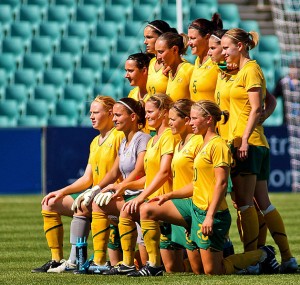chicks with balls: the matildas
Join Lip’s Ally Van Schilt for her new fortnightly column for all things women’s sport!
Every four years, sporting mad Australians go into a frenzy about the FIFA World Cup, the Australian team’s chances, the green and gold gear comes on in force, and sporting channels tend to be watched in all hours of the morning to catch the games live. This year to be held in Brazil (which is a volatile enough situation to justify an entire article upon), the talk has long begun about the Socceroos, selection dilemmas, Australia’s extremely tough drawcard and even a McDonalds range of limited edition hamburgers being released to celebrate this occasion.
However, just about all of this warrants qualification: ‘sporting mad Australia’ should probably be re-termed as ‘male sporting mad Australia’, as around 98 per cent of the focus in the build-up to the World Cup has been upon the male squad, the Socceroos. In fact, Australia has an extremely successful, talented and athletic female soccer squad, the Matildas, who this year, for the second time in a row, advanced to the Asian Cup final. The Matildas were this year the reigning champions, aiming to defend their 2010 title, where they defeated Korea in an historic match, which saw the Matildas being the first ever Australian squad to win in Asia, in a penalties match which resulted in the 5-4 score line. This year, unfortunately, the team went down to Japan 1-0, despite a strong second half fight back from the Australians.
The Matildas have a very strong history in recent times in women’s championships and major tournaments, such as the Asian Cup final. However, unlike male Socceroos players, the Matildas receive comparatively little publicity and hype surrounding their games and their successes. Watching the average television sporting news, the Matildas are lucky to receive any mention at all, and when their endeavours are reported on, they are often in relation to their male counterparts, rather than in their own right. For example, a major television news program referred to the team’s success in qualifying for the Asian Cup following news on the Socceroos as ‘taking it up to the men’, and receiving about a third of the air time despite this fantastic achievement and all of the hard work it took for the women to get to such a point (which wasn’t mentioned at all in any previous major news bulletins that I saw).
This establishes a sadly recurring trend within the sporting media, as we saw demonstrated with my last column on Women’s Round in the Australian Football League. There does not appear to be a problem within the codes of sport themselves; in fact, women’s leagues of soccer and football (or football and AFL, depending on how you term them) are thriving and succeeding. However, concurrently, the media coverage surrounding women’s codes is diminishing. This case of the Socceroos as opposed to the Matildas is just another example of how this is happening. Female sportspeople receive a fraction of the coverage, media and space in the media as their male counterparts, and it results in a nasty inequality. This lack of coverage generates lack of interest in their games and sport, which means that they play in smaller venues, in front of smaller crowds, which means less funding, less sponsorship deals, and less money to pay the athletes to keep doing what they’re doing. Where we see male football players signing multimillion dollar contracts and garnering exclusive sponsorship deals, many female athletes also have to work another full time job in order to keep playing their sport at an elite or even national level. This kind of inequality simply should not exist in the sporting world – or in any world, truth be told.
The solution to the problem is not an easy one. Shifting the patriarchal attitude towards sport in Australia seems like an impossible task, especially considering how long this has been instituted into our country. But every little effort makes a difference. After all, equal with an Australian love of sport is a love of winning, and considering so many of our women’s national teams are so successful, it provides an incentive to those stubborn reinforcers of the patriarchy. I’m not at all encouraging a boycott of the FIFA World Cup (certainly not based on these reasons anyway); however, I am encouraging everybody to know that there is an equally thriving women’s competition which deserves much more attention and coverage than it has been and continues to currently receive.
Stay tuned for Ally’s next instalment of Chicks with Balls in a fortnight on Lip, for all your women’s sporting news and opinions.


